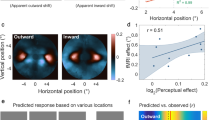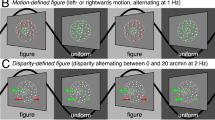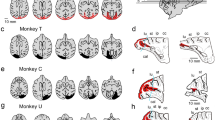Abstract
A VISUAL cue that is often associated with significant stimuli, such as those provided by prey and predators, is movement relative to the observer. An efficient visual system should be able to direct attention to those parts of the visual field that contain such stimuli. What is needed is a system that can filter by movement difference. This could direct attention to a moving item among stationary items, or an item moving in one direction against a background moving in a different direction. Visual search experiments have shown that people are indeed able to filter by movement; that is, they can attend to just the moving items in arrays of moving and stationary stimuli1. Single-cell recordings from monkey visual cortex show that the medial temporal cortical area (MT) has some of the properties required to filter by movement2–4. We have now linked these two observations by showing that a patient with bilateral lesions to the presumed human homologue of MT cannot restrict visual attention to the moving items in arrays of both moving and stationary items. This suggests that MT is the site of a movement filter used in normal visual processing.
This is a preview of subscription content, access via your institution
Access options
Subscribe to this journal
Receive 51 print issues and online access
$199.00 per year
only $3.90 per issue
Buy this article
- Purchase on Springer Link
- Instant access to full article PDF
Prices may be subject to local taxes which are calculated during checkout
Similar content being viewed by others

References
McLeod, P., Driver, J. & Crisp, J. Nature 332, 154–155 (1988).
Felleman, D. & Kaas, J. J. Neurophysiol. 52, 488 (1984).
Albright, T. J. Neurophysiol. 52, 1106–1130 (1984).
Allman, J., Miezin, F. & McGuinness, E. Perception 14, 105–126 (1985).
Zihl, J., von Cramon D. & Mai, N. Brain 106, 313–340 (1983).
Treisman, A. & Gelade, G. Cognit. Psychol. 12, 97–136 (1980).
Treisman, A. Q. J. exp. Psychol. 40, 201–238 (1988).
Author information
Authors and Affiliations
Rights and permissions
About this article
Cite this article
McLeod, P., Heywood, C., Driver, J. et al. Selective deficit of visual search in moving displays after extrastriate damage. Nature 339, 466–467 (1989). https://doi.org/10.1038/339466a0
Received:
Accepted:
Issue Date:
DOI: https://doi.org/10.1038/339466a0
This article is cited by
-
Electrical charging overcomes the bouncing barrier in planet formation
Nature Physics (2020)
Comments
By submitting a comment you agree to abide by our Terms and Community Guidelines. If you find something abusive or that does not comply with our terms or guidelines please flag it as inappropriate.


